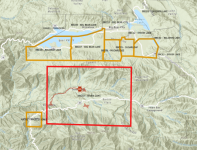
Big Bear News – Big Bear Lake, CA – Fire officials with San Bernardino National Forest are preparing for two notable prescribed burning projects over the next two weeks across the forest. The first, adjacent to the city of Big Bear Lake, is planned to begin this Thursday. The second, with plans for ignitions beginning next week, will be southeast of Idyllwild.
Both projects will be broadcast burns, in which fire crews treat an area within a pre-determined boundary to mimic a low-intensity fire ignited by a lightning strike.
South Big Bear
Crews plan to treat up to 15 acres directly adjacent to the lower end of the Moonridge neighborhood, near the intersection of Club View Dr., and Willow Ave., beginning Thursday, Feb. 3. Reducing dead and down woody debris will make the area safer for firefighters to work behind homes in the event of a wildfire. Crews will remain on scene throughout the weekend as the fire continues to smolder and show smoke before mopping up.
The area will not be closed to the public, but visitors should exercise caution when using the Bristlecone (1E32), Fall Line (1E30) and Fern (1E31) trails.
Thomas Mountain
Beginning the week of Feb. 7, crews plan to begin work on a multi-week burn of up to 600 acres near the community of Garner Valley, southeast of Idyllwild. Work at this location builds upon previous years of prescribed burning to decrease the fire behavior of a potential wildfire approaching the community. Each day of the project will differ: Some days, crews will conduct ignitions and other days they will patrol and monitor areas with smoldering fire.
Like with the South Big Bear project, the area will not be closed to the public. Visitors to the Ramona (3E26) and Thomas Mountain Bike (3E27) trails, Thomas Mountain Rd. (6S13), and the Toolbox Springs Yellow Post Sites may see fire and experience smoke.
Future projects
More broadcast prescribed burning is planned for later this winter and spring, including near Big Bear Lake, Idyllwild-Pine Cove, Lake Arrowhead, Running Springs and Angelus Oaks.
Pile burning, which is done for fuels clearance around Forest Service facilities or before areas can be treated with a broadcast approach, will also occur throughout the Forest. To date, over 80 acres of pile burning has been accomplished this season.
Notices for the larger and more noticeable projects will be published in press releases, social media and the Forest’s website.
Why conduct prescribed burns?
In addition to helping firefighters protect communities and infrastructure, prescribed burning is an active forest management activity that helps restore ecological functions to ecosystems. Fire has a natural role in coniferous regions of the San Bernardino National Forest. Caused naturally by lightning, fire has long maintained the health of forests, clearing brush on the forest floor and releasing seeds from pine cones, among other natural processes.
Drought, fuel buildups and fire exclusion—all compounded by climate change and homes spreading into fire-prone landscapes over the past century—have increased the severity of wildfires and allowed fuels to unnaturally build up. That build up results in an overabundance of flammable brush, which can enable wildfire to quickly spread into the canopy and toward communities and infrastructure.
Why now?
We only burn when conditions make it safer to do so. The “burn boss,” the person in charge of a prescribed burn, assesses numerous factors each morning before ignitions can begin. These factors include wind, humidity, air quality, fuel moisture and availability of fire crew personnel. If the criteria are met, creating a so-called “burn window,” crews may move forward with burning.
What about all the smoke?
Fire planners make every effort to reduce the impact of smoke to communities when identifying potential burn windows. Forecasted wind patterns are taken into consideration, as well as consulting the local air quality management district. Overall, we are looking to reduce the impacts, including smoke, from major wildfires during peak fire season.
What can I do to help?
Forest officials encourage property owners to also do their part by following their local fire abatement regulations for creating defensible space around their structures. Additionally, CAL FIRE has tips for defensible space, home hardening and native plant landscaping at ReadyForWildfire.org.


